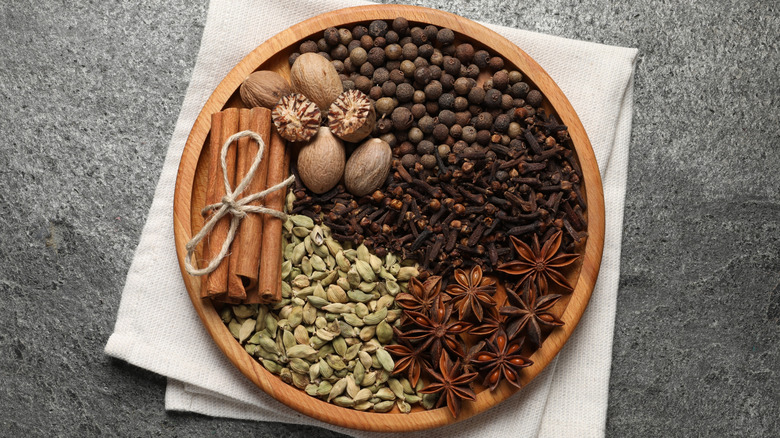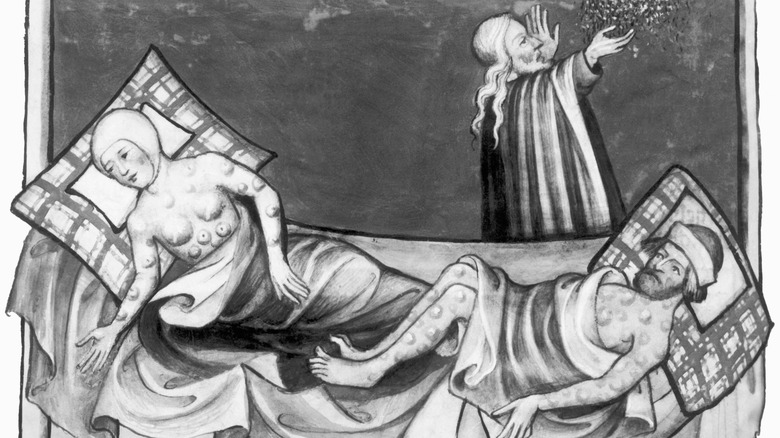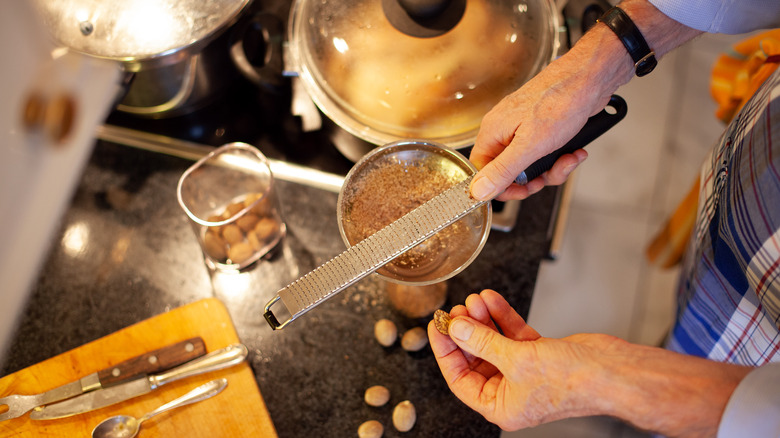The Popular Baking Spice That Allegedly Used To Prevent Black Death
Most folks learned about the Black Plague during school, though you might also know it by its other names — the Black Death and bubonic plague. This devastating illness has left many imprints on our current society, ranging from wine windows in Italy that limit human contact to household clocks and sanitation practices. One surprising result of the disease is that most homes contain nutmeg in their spice racks. This isn't because people were hungry for good cooking while sick with bubonic plague. Instead, nutmeg became a sought-after staple during the 1300s and 1600s plague outbreaks because people thought it was a cure.
As you might guess from the millions who died during the initial bubonic plague and later resurgence, nutmeg was not an effective cure. However, that doesn't mean doctors of the time were just making desperate guesses. Nutmeg was already being administered as a psychoactive drug, with documented results, and it was commonly used to help with gut problems and joint pain. They didn't know it at the time, but nutmeg also has antibacterial properties, similar to medicine that modern science has found effective in treating early stages of bubonic plague. The spice has remained a valuable medicine as well as a yummy flavoring over the years, and we owe that in part to its coveted status during the Black Plague.
Treating the Black Plague
With the bubonic plague unexpectedly resurging in recent years, the disease is still a matter of scientific fascination. We now know that the plague is spread by fleas infected with Yersinia pestis bacteria, carried on rats throughout Europe and other continents. At the time, however, there were numerous thoughts as to how it proliferated and how best to treat it. Doctors often wore plague masks that were filled with spices and purported medicinal substances, one of them being nutmeg. While it has been documented that fleas avoid nutmeg, perhaps protecting people on rare occasions, it was not effective in treating those already suffering from the disease and did not stop the plague's ruinous spread.
This might come as a shock, but keep in mind that nutmeg is actually a very effective poison. Many medicines today are small quantities of substances that are poisonous in larger amounts, so it's no surprise that physicians of the era gave this spice a try when looking for treatments. At the time, doctors thought the plague was spread through a deadly miasma in the air. They also believed that nutmeg, when applied to the body or worn around the neck, could keep the evil miasma away. This was such a popular belief that the price of this spice saw a 6,000% markup in parts of Europe by the 1500s, even after the plague had ebbed. This cemented its place as a beloved spice, a status that endures even now.
Nutmeg is still used as a medicine and cooking ingredient
While nutmeg was not, in fact, useful in treating or preventing the Black Plague, that doesn't mean it's not medicinal. Even today, societies around the world use it to help with various ailments, and some of these uses are backed up by science. It has antimicrobial abilities, might help soothe inflammation, and is rich in antioxidants, which may help prevent cellular damage. For those with high blood sugar and cholesterol, studies show that it can help lower both of these substances. Nutmeg is not a miracle cure, and it has some risks if taken improperly, but research has shown that it can be beneficial to health in certain quantities.
Of course, when it's not being used medicinally, this spice is a staple of both sweet and savory cooking. It's the spice that can amp up your Alfredo sauce and that perfect touch to make ginger cookies taste Christmassy. You can add it to finish off your eggnog or cocoa, and it makes creamy rice pudding really sing. You couldn't have a pumpkin-spice latte without it! Although nutmeg may not have been too effective at warding off the Black Plague, it is still a spice every kitchen should have.


